Radios are great tools for communicating with hunting partners, emergency personnel, and other people on the trail.
It’s a good idea to get a license and keep a handheld ham radio in your equipment.
However, handheld ham units are small and don’t have much power. Radio transmission range is dependent on both height and output, measured in watts, and handheld radios rarely push more than 8 watts.
You also get height not only from standing in a high place but also from using a longer antenna.
So, what do you do when you need to contact someone more than a few miles away?
That’s when you need a much more powerful radio with a longer antenna: a mobile ham radio.
Also called a car ham radio, these generally mount to your vehicle, though some people set them up as home stations as well.
Let’s look at your mobile radio options.
The 6 Best Mobile Ham Radios of 2021: Outdoor Empire Reviews
- Best Cheap #1: QYT KT-8900D
- Best Cheap #2: Kenwood TM-281A
- Best Dual Band #1: BTECH Mobile UV-50X2
- Best Dual Band #2: AnyTone AT-5888UV
- Best All-Band #1: Yaesu Original FT-8900R
- Best All-Band #2: TYT TH-9800 Plus
| Category | Best cheap | Best dual band | Best all band |
|---|---|---|---|
| Product | 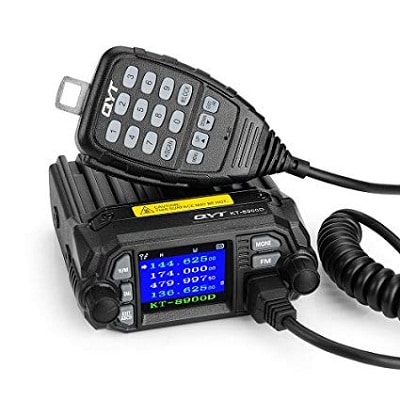 | 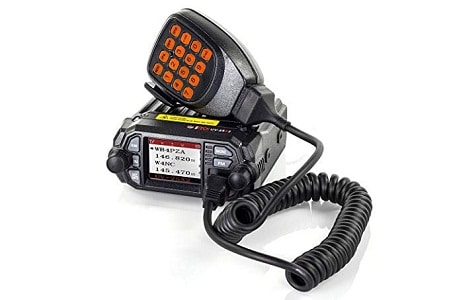 | 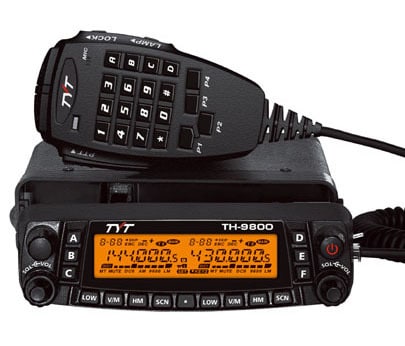 |
| Bands | VHF, UHF | VHF, UHF | 10-meter HF, 6-meter VHF, 2-meter VHF, and 70-centimeter UHF |
| Frequency Ranges | 136–174 MHz 400–480 MHz | 136–174 MHz 400–520 MHz | 26–33 MHz 47–54 MHz 134–174 MHz 400–480 MHz |
| Channels | 200 | 200 | 809 |
| Transmission Power | Up to 25 watts | 50 / 10 watts | 50 / 20 / 10 / 5 watts |
| Pros | - Good sound quality - Receives and transmits very well despite the low price | - Customizable display - Expanded frequency ranges within the bands - Good for multi-channel operation | - Four power options - Four transmission bands |
| Cost | Check Price | Check Price | Check Price |
1. Best Cheap Mobile Ham Radio #1
- Good sound quality
- Receives and transmits very well despite the low price
- Mediocre knobs
- Poor instructions
- Bands: VHF, UHF
- Frequency Ranges: 136–174 MHz, 400–480 MHz
- Channels: 200
- Transmission Power: Up to 25 watts
Overview
The QYT KT-8900D is a small, mobile, two-way radio that works surprisingly well considering the low price.
It transmits on two amateur radio bands. VHF gets 25 watts while UHF gets 20 watts. This is a small amount of power for a mobile station, but it can be powered by your vehicle’s cigarette outlet and doesn’t need to be directly wired to your car or truck.
The KT-8900D comes with a programming cable so you can program the radio with a computer app such as CHIRP.
However, it doesn’t come with an antenna, so you’ll need to provide your own antenna and antenna mount.
Also, the rubber knob covers don’t hold up well, and the included instructions are worthless. Thankfully, you can find good how-to videos online.
QYT had to cut some physical corners to get this transceiver under $100, but it does a good job as a ham radio. Add the right antenna, and you’ll be able to talk to stations over 50 miles away!
Recommendation
Most mobile ham radios are over $100, but the QYT KT-8900D gets the job done for less than $100. You’ll need to bring your own antenna, though.
2. Best Cheap Radio #2: Kenwood TM-281A
- Bands: VHF
- Frequency Ranges: 144–148 MHz
- Channels: 200
- Transmission Power: 65 / 25 watts
Overview
The Kenwood TM-281A is a simple unit. It doesn’t do everything, but what it does do it does very well.
This single-band ham radio transceiver can only receive and transmit in the 2-meter band. This may seem limiting but, if you’re not going to use other bands, why pay for capabilities you don’t need?
The TM-281A has two power modes. Low-power works at 25 watts from your vehicle’s cigarette lighter. The high-power mode requires a directly wired connection but outputs a massive 65-watts of transmission power!
If you add a good antenna, and you’ll need to because the TM-281A doesn’t come with one, you’ll be able to contact repeaters over 100 miles away!
This radio will last you a long time, too. It meets many mil-spec standards for shock and vibration resistance and is made from durable aluminum and high-quality polymers.
There are also plenty of features such as CTCSS, DTCS, weather alerts, and more. Oh, and while it can store 200 channels, that’s without giving them names. That cuts the available channels down to 100.
Pros
- MIL-STD 810 C, D, E, F, and G shock and vibration resistance
- Very powerful
Cons
- Only one band
Recommendation
If you only need a single band then the Kenwood TM-281A will give you all the power and durability you need without tearing into your pocketbook.
3. Best Dual Band Mobile Ham Radio #1
- Customizable display
- Expanded frequency ranges within the bands
- Good for multi-channel operation
- Small, crowded screen
- Bands: VHF, UHF
- Frequency Ranges: 136–174 MHz, 400–520 MHz
- Channels: 200
- Transmission Power: 50 / 10 watts
Overview
The BTECH Mobile UV-50X2 is a two-way mobile radio by BaoFeng that’s packed with features.
If you like to tinker with your electronic devices, then the UV-50X2 is a good choice for you. Though the display screen is rather small, you can customize it with nine different colors, add alphanumeric names to channels, and even display and monitor four channels at once. You can also monitor channels while scanning frequencies!
You can also add or remove channels on the unit itself or plug it into a computer for easier programming.
High power broadcasts at 50 watts and low power at 10 watts, though those are nominal numbers. Some users have reported that the unit is more powerful than advertised and can transmit at 65 watts!
The UV-50X2 is compatible with all the common and some uncommon analog tones, so you can use groups.
Watch out, though. It has an expanded frequency range which can get you into trouble if you transmit on a frequency your license doesn’t cover!
Recommendation
The BTECH Mobile UV-50X2 is dual-band two-way radio that can take advantage of both bands at once and packs a lot of features into an inexpensive mobile unit.
4. Best Dual Band Radio #2
- Simultaneous reception
- USB port for phone charging
- Mediocre build quality
- Slow scanning speed
- Bands: VHF, UHF
- Frequency Ranges: 136–174 MHz, 400–490 MHz
- Channels: 758
- Transmission Power: Up to 50 watts, down to 5 watts
Overview
The AnyTone AT-5888UV is another dual-band mobile radio transceiver that’s a good choice if you want to use both 2-meter and 70-centimeter ham bands.
Four power options let you choose just how much juice you need to contact your listener without hitting everyone around. The maximum power is 50 watts (40 for UHF operation), and the minimum power is 5 watts.
The connections use non-proprietary CAT5 plugs, so you can easily add your own accessories. There’s even a USB port, so you can charge your phone from the unit.
The display screen is set up to monitor two channels at once. You can even receive two calls at the same time!
There are also cross-band repeating capabilities for when you want to send during someone else’s message.
Both the transceiver and microphone have built-in speakers. The microphone also has more controls than the average mic.
The build quality isn’t the best. The radio’s face is somewhat flimsy, and the rest of the unit is surprisingly open. This shouldn’t be a problem unless you’re splashing mud into your interior, though.
Recommendation
The AnyTone AT-5888UV is a good dual-band ham radio transceiver that can do everything you want it to do, so long as you don’t beat up the case.
5. Best All-Band Mobile Ham Radio #1: Yaesu Original FT-8900R
- Bands: 10-meter HF, 6-meter VHF, 2-meter VHF, and 70-centimeter UHF
- Frequency Ranges: 28–29.7 MHz, 50–54 MHz, 108–180 MHz, 300–480 MHz
- Channels: 800
- Transmission Power: 50 / 35 watts
Overview
The Yaesu Original FT-8900R is a quad-band radio, so it’s much more flexible than most other mobile ham radios.
The FT-8900R can transmit on four bands: 10-meter HF, 6, and 2-meter VHF, along with 70-centimeter UHF. The output power maxes out at 50 watts for HF and VHF transmission and 35 watts for UHF transmission.
It can also receive FM radio, 700–985 MHz (excluding cellular frequencies), and expanded frequencies around the other bands.
Add a good antenna, and you can contact far-away repeaters. Cross-band repeat lets you use this transceiver to continue calls from a handheld unit, too.
The speaker and microphone are both very high-quality, so you’ll be able to clearly hear transmissions, and people down the line will hear you clearly as well.
There are some nifty usability features, too. For example, it has Hyper Memory, which records not only frequency but also other settings such as Automatic Repeater Shift and your VFO/scanning options.
It’s even compatible with FM satellites!
Pros
- FM-satellite capable
- Great audio quality
- Quad-band capability
- Receives on an expanded frequency range
Cons
- Expensive
Recommendation
If you want maximum transmission coverage and to listen in to almost any radio broadcast, then you want the Yaesu Original FT-8900R. But, you’ll pay for it.
Learn more about the Yaesu Original FT-8900R.
6. Best All-Band Radio #2
- Four power options
- Four transmission bands
- Potentially faulty fuses
- Bands: 10-meter HF, 6-meter VHF, 2-meter VHF, and 70-centimeter UHF
- Frequency Ranges: 26–33, 47–54, 134–174, 400–480 MHz
- Channels: 809
- Transmission Power: 50 / 20 / 10 / 5 watts
Overview
The TYT TH-9800 Plus is another quad-band radio that can transmit and receive on HF, two VHF, and UHF bands. It can also receive radio transmissions in those bands plus 108–136, 320–399, and 750–950 MHz frequencies.
The transceiver uses between 50 and 5 watts of power to transmit in VHF. UHF output maxes out at 40 watts.
The TH-9800 is full-duplex and has cross-band repeat. It has 809 channels and 256 memories, so your settings stay saved.
Programming is easy on the radio itself. If you prefer programming with your computer, the unit comes with a programming cable and proprietary programming software, but it is also compatible with CHIRP.
Several users have reported that the TH-9800 failed to power up when first received. The solution is to swap out the fuse. A spare is included, but it might be a good idea to supply your own.
The faceplate is detachable and can be installed remotely.
Make sure to use a 13.8-volt quad-band antenna, not a 24-volt antenna!
Recommendation
The TYT TH-9800 Plus is a great quad-band ham radio transceiver. Be sure to buy the Plus version, though, because it’s more reliable than the non-Plus version.
What Are Mobile Ham Radios?
A mobile ham radio, despite the name, is not a radio you give to a flying pig.
Instead, it’s a halfway-point between handheld amateur radios and amateur radio stations.
“Ham” is the name amateur radio operators have taken for themselves, so any non-commercial radio that’s not an FRS, GMRS, or marine radio is a ham radio.
Mobile radios are two-way radio transmitters and receivers, or transceivers, that are designed to be mounted to a vehicle.
So, they’re mobile but require too much power to be a handheld unit.
This extra power gives them a potential boost to range that is realized when you put a long, high-quality antenna atop your vehicle. This can give you 50 miles of range, if not 100 or more!
What Are They Used For?
Mobile ham radios are used by people in or around vehicles who need to communicate more swiftly or frequently than they can with cell phones, in areas where there’s no cellular signal, or with people whose phone number you do not know.
These radio transceivers are also often full-duplex, which means they can receive a transmission from one radio and transmit it to others down the line. This makes them effectively repeaters, good for extending the range of handheld radios.
Therefore, mobile ham radios are good for off-roaders, families vacationing in two cars, and people who might get lost in the wild and want a longer range than even the most powerful handheld radio will allow.
How to Choose
Even the cheapest mobile ham radio is an investment.
You have to consider not just the cost of the radio itself but also the antenna you’ll want to use. That antenna will also have to be mounted to your vehicle, which adds a couple of dollars as well.
However, this investment will pay off if you use the radio to save a life during an emergency.
Three main conditions affect a radio’s price:
- Build Quality
- Power
- Bands
Let’s look at those in detail.
Build Quality
Generally, the more you spend on a radio, the higher the build quality will be. Not always, though!
For example, the Kenwood TM-281A has the highest build quality of any radio on this list, though it is the second cheapest. How? Because it can only transmit on one band.
However, most people don’t need to worry too much about how tough your radio is built.
Anything inside a car or truck is generally safe and protected from the environment. So, you don’t need to care too much about how well your radio is built so long as it functions well as a transceiver.
However, mudders and off-roaders are in a different situation.
Mudding and other similar activities can bring the environment inside your vehicle. Cheaply built radios will fall quickly to these hobbies, so make sure to buy something well built!
Off-roading isn’t as harsh on your radio, but it does cause a lot of vibration, and sudden movements can transmit shock to your transceiver.
This can cause some ham radio units to fail. This can happen because of solder joints cracking, screws unscrewing, or a thousand other small issues that will add up over time.
So, if you’ve upgraded your vehicle’s shocks because you’re using them, you might want to consider buying a hardier ham radio rather than one packed with fancy features.
Power
Mobile ham radios are more powerful than their handheld siblings, but there’s still a range of power in this radio class.
I’d recommend getting a mobile radio that has a minimum maximum power of 25 watts. That’s the most electricity you can get out of a car’s cigarette lighter and is good enough, when paired with an antenna, to send your transmissions out for dozens of miles.
Anything less is good for only simple operations. Sure, talking to another car in your convoy is good, but that won’t help if your vehicle breaks down on the side of the road.
More power is better, though not linearly so. Fifty watts is a good amount of output. Sixty-five watts will get you a little more range, but in practice, it might not be very noticeable.
Remember, you don’t need to use your radio at maximum power all the time. In fact, that can be rude since you’ll broadcast to people further away than your intended recipient. It can also drain your car’s battery if you use the radio without the engine on.
Actually, I’ve drained a truck battery in minutes from using the radio transceiver with the engine off. That was a busy channel, though.
So, it’s a good idea to only use your mobile ham radio when the vehicle’s engine is running and generating electricity.
Bands
Ham radio bands are labeled by the average signal wavelength of the frequencies within that band.
2 Meter
For example, the 2-meter band refers to the 144-MHz VHF (very high frequency) band that generally ranges from 144 to 148 MHz. Those wavelengths average 2 meters in length.
The 2-meter band is also the most-commonly-used ham radio band. It can get crowded in some areas, but it’s also very long-ranged, and you have the highest possibility of reaching someone in an emergency.
70 Centimeter
Seventy centimeters is the next most common band and is also called the 440-MHz band. It goes from 420 to 450 MHz in the US, though other countries allocate fewer frequencies.
If someone says “UHF” (ultra-high frequency) in relation to ham radios without any other qualifiers, it refers to the 70-centimeter band.
You’ll have more room to speak on the UHF band but transmissions on this band don’t propagate as far as VHF transmissions.
6 Meter
The 6-meter band is at the low end of VHF at around 50 MHz. It’s not as commonly used as the other VHF band, which is a shame since it vastly increases the distance you can transmit a radio signal.
Six-meter VHF is also called “the magic band” because it has extremely good propagation characteristics. During periods of solar activity, the Earth’s ionosphere can allow communication at ranges up to 1,600 miles without a repeater!
You won’t get that with a mobile radio, but you’ll still outrange 2-meter radio operators. Also, nearby electrical devices can interfere with these radio transmissions.
You do need a much longer antenna to transmit on this band.
10 Meter
The 10-meter band, around 28 MHz, falls under HF (high frequency). It can propagate extremely far but is greatly dependent on the Earth’s atmosphere; 28 MHz radio waves can refract from the F2 layer of the ionosphere during periods of solar activity.
This gives this band an incredibly long range, but only when the sun is overhead. If the sun is actively spewing sunspots and is above you, you’ll be able to contact other continents.
That said, you’ll need a 10-meter antenna to transmit on this band.
The Antenna
The crux of any mobile ham radio is not the transceiver itself but the antenna.
You have to have an antenna that is rated for the bands you want to use, is long enough to transmit well, and has a compatible voltage.
The antenna may also need its own power supply.
Most mobile ham radio transceivers will recommend an antenna. Users also often report which antennas they use in their reviews.
Finally, you need to mount that antenna on top of your vehicle. Keeping it inside won’t work because your car’s metallic body will block the radio waves.
Antenna Mounts
Magnetic mounts are the most commonly used antenna vehicular mounts. They’re easy to use and are effective for smaller antennas.
However, larger antennas, such as quad-band antennas, can catch too much of the wind for a magnetic mount.
Luckily there are also clip in mounting brackets that can hold heavier antennas without trouble.
You’ll be able to get by with a magnetic mount most of the time, though. Plus, with a mag mount, you can easily take down the antenna when you don’t want to use it, such as when you are using your truck for commuting to work.
You don’t want that big ol’ antenna to call a thief’s attention to your expensive ham radio, after all!


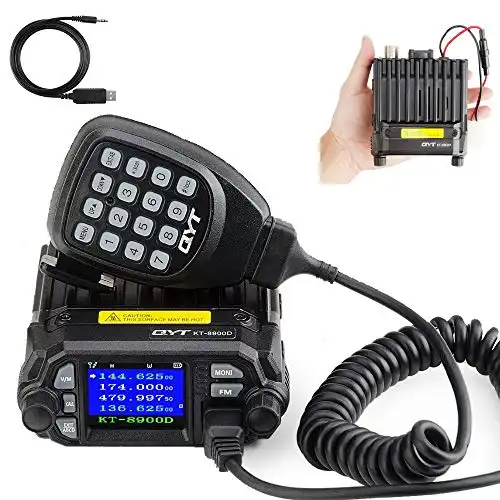
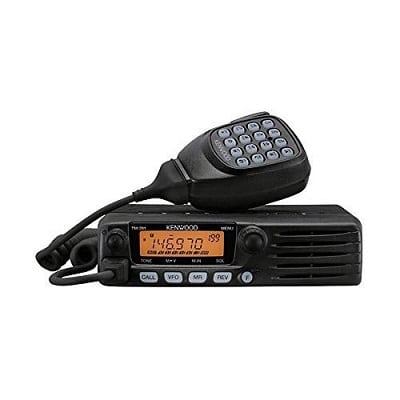
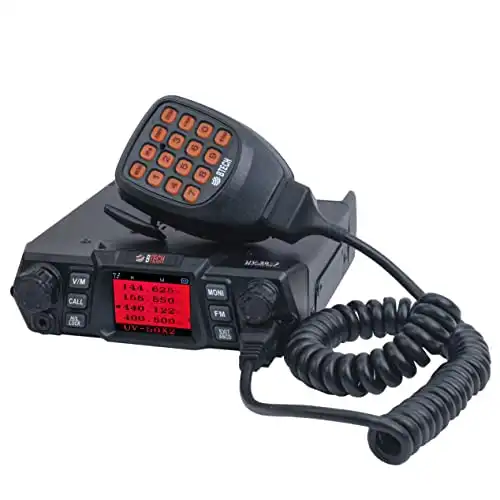

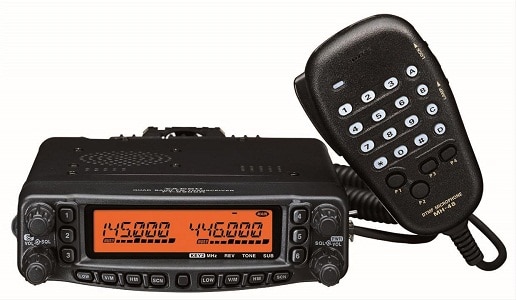
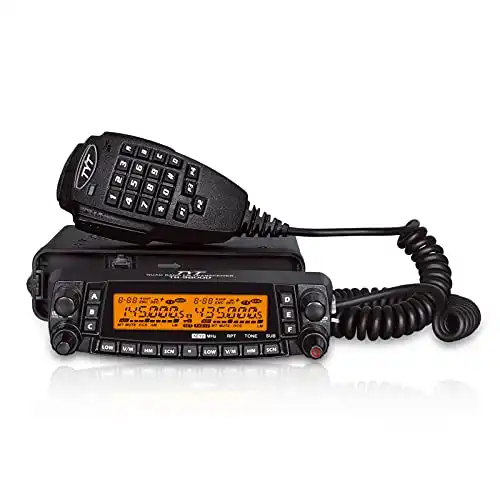
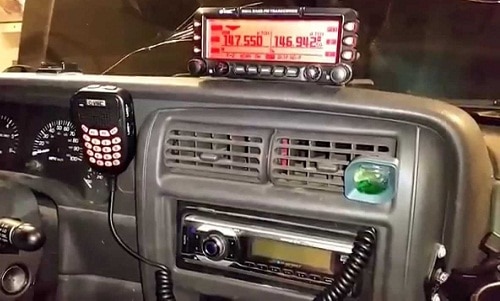
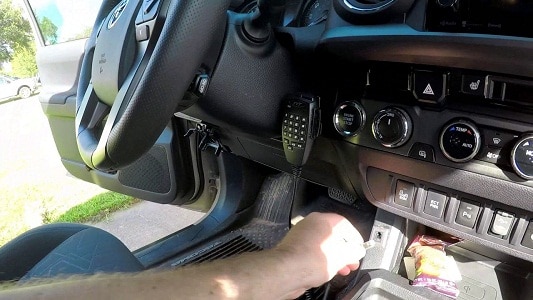
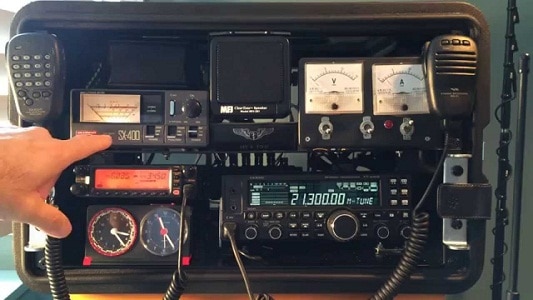
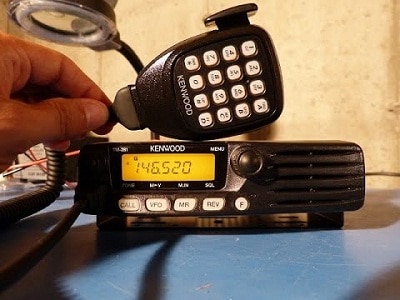
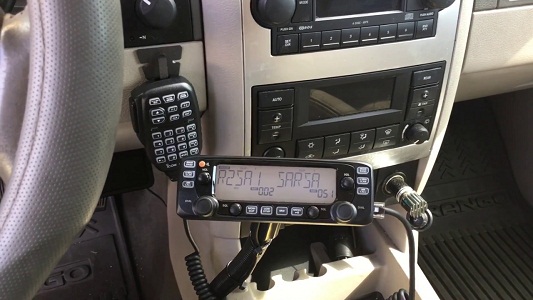
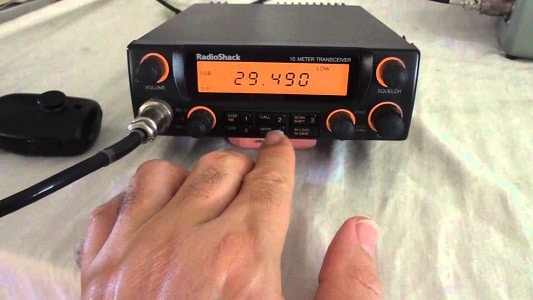
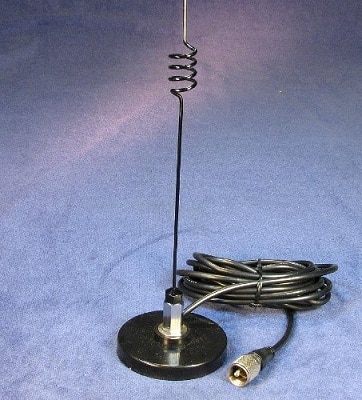
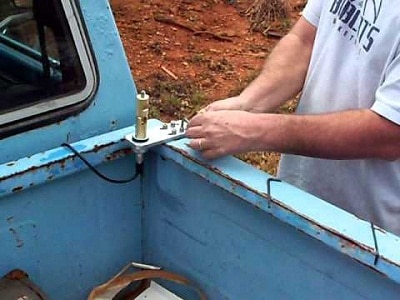


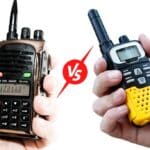

Comments are closed.